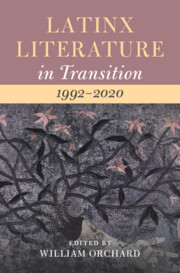Refine search
Actions for selected content:
44 results
Chapter 19 - Avant-Gardist
- from Part III - Culture, Society, and Politics
-
-
- Book:
- María Irene Fornés In Context
- Published online:
- 27 August 2025
- Print publication:
- 07 August 2025, pp 205-215
-
- Chapter
- Export citation
Chapter 26 - Documentation
- from Part IV - Legacy
-
-
- Book:
- María Irene Fornés In Context
- Published online:
- 27 August 2025
- Print publication:
- 07 August 2025, pp 298-307
-
- Chapter
- Export citation
Chapter 18 - Hispanic/Latinx/Latiné
- from Part III - Culture, Society, and Politics
-
-
- Book:
- María Irene Fornés In Context
- Published online:
- 27 August 2025
- Print publication:
- 07 August 2025, pp 194-204
-
- Chapter
- Export citation
Chapter 14 - The Epistemic Disobedience of Latinx Shakespeares
- from Part IV - Transcreating
-
-
- Book:
- Latinx Literature in Transition, 1444–1886
- Published online:
- 06 August 2025
- Print publication:
- 17 July 2025, pp 319-340
-
- Chapter
- Export citation
What Race Am I?: Factors Associated with Racial Self-classification Among U.S. Latinx Adults
-
- Journal:
- Du Bois Review: Social Science Research on Race , First View
- Published online by Cambridge University Press:
- 10 July 2025, pp. 1-22
-
- Article
-
- You have access
- Open access
- HTML
- Export citation
Chapter 14 - Sonic Latinidades in Latinx Theater and Performance
- from Part III - Emerging Media
-
-
- Book:
- Latinx Literature in Transition, 1992–2020
- Published online:
- 19 June 2025
- Print publication:
- 03 July 2025, pp 258-278
-
- Chapter
- Export citation

Latinx Literature in Transition, 1992–2020
-
- Published online:
- 19 June 2025
- Print publication:
- 03 July 2025
Chapter 20 - Latinx Realism
- from Part IV - Locations of Realism
-
-
- Book:
- Realism and the Novel
- Published online:
- 05 June 2025
- Print publication:
- 19 June 2025, pp 286-299
-
- Chapter
- Export citation
Language justice as an antiracism institutional transformation: Institutional facilitators and barriers for community-engaged cardiometabolic health promotion research
-
- Journal:
- Journal of Clinical and Translational Science / Volume 9 / Issue 1 / 2025
- Published online by Cambridge University Press:
- 24 February 2025, e73
-
- Article
-
- You have access
- Open access
- HTML
- Export citation
Chapter 17 - Rethinking Critical Geographies
-
-
- Book:
- The New Nineteenth-Century American Literary Studies
- Published online:
- 02 January 2025
- Print publication:
- 23 January 2025, pp 249-264
-
- Chapter
- Export citation
Chapter 9 - Nineteenth-Century Spanish-Language Textbooks and US American Literature
-
-
- Book:
- The New Nineteenth-Century American Literary Studies
- Published online:
- 02 January 2025
- Print publication:
- 23 January 2025, pp 128-143
-
- Chapter
- Export citation
16 - Familism Values and Disclosure Among Latinx Youth
- from Part III - Informant and Contextual Differences in Disclosure and Secrecy
-
-
- Book:
- The Cambridge Handbook of Parental Monitoring and Information Management during Adolescence
- Published online:
- 12 December 2024
- Print publication:
- 19 December 2024, pp 326-341
-
- Chapter
- Export citation
8 - Ecological and Developmental Approaches to Reducing Substance Use and Related Harms among Emerging Adults
- from Part Three - Prevention with Emerging Adults
-
-
- Book:
- An Ounce of Prevention
- Published online:
- 14 November 2024
- Print publication:
- 28 November 2024, pp 155-174
-
- Chapter
- Export citation
7 - Reinscribing Lost Imaginaries of Semiolingual Innocence
-
- Book:
- Literacies of Migration
- Published online:
- 30 November 2024
- Print publication:
- 21 November 2024, pp 211-238
-
- Chapter
- Export citation
Stress management preferences and stress experiences among Latinx immigrants in the United States during the COVID-19 pandemic: Mixed-methods results from a community-academic research team
-
- Journal:
- Cambridge Prisms: Global Mental Health / Volume 11 / 2024
- Published online by Cambridge University Press:
- 23 October 2024, e94
-
- Article
-
- You have access
- Open access
- HTML
- Export citation
1 - Setting the Stage: Diversity and Democracy
- from Part I - Diversity and American Democracy
-
- Book:
- Race and Inequality in American Politics
- Published online:
- 09 November 2024
- Print publication:
- 17 October 2024, pp 3-33
-
- Chapter
- Export citation
Chapter 5 - Racing Latinidad
- from Part II - Backgrounds
-
-
- Book:
- The Cambridge Companion to Race and American Literature
- Published online:
- 02 November 2024
- Print publication:
- 27 June 2024, pp 74-87
-
- Chapter
- Export citation
Chapter 12 - Student Success Considerations for First-generation, Working-class Latinx College Students
- from Part III - Institutional Arrangements
-
-
- Book:
- Supporting College Students of Immigrant Origin
- Published online:
- 16 May 2024
- Print publication:
- 23 May 2024, pp 249-267
-
- Chapter
- Export citation
Chapter 7 - Latinx Belonging in New World Borders
-
-
- Book:
- The Cambridge Companion to American Utopian Literature and Culture since 1945
- Published online:
- 09 May 2024
- Print publication:
- 16 May 2024, pp 133-151
-
- Chapter
- Export citation
37 - Latinx Culture and the Essay
- from Part IV - Toward the Contemporary American Essay (2000–2020)
-
-
- Book:
- The Cambridge History of the American Essay
- Published online:
- 28 March 2024
- Print publication:
- 14 December 2023, pp 627-642
-
- Chapter
- Export citation
